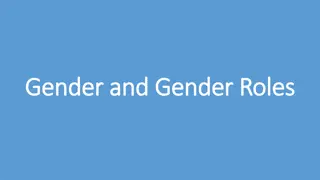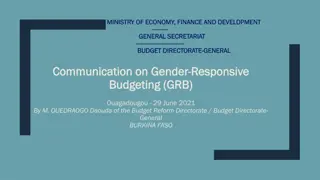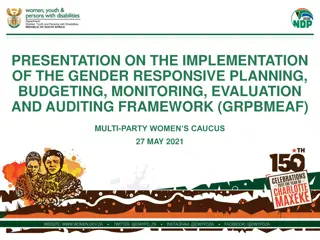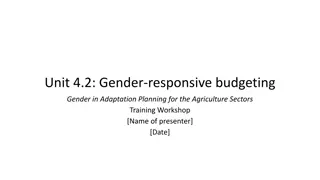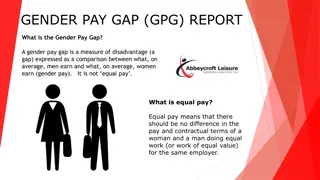Gender Disparities in Economics: Challenges and Solutions
Gender disparities persist in the field of economics, impacting women's representation, tenure, salaries, and job satisfaction. Factors driving these gaps include differences in productivity, family responsibilities, biased evaluations, and research choices. The leak of women in the tenure process from assistant to associate professor remains unexplained, highlighting the need for addressing systemic issues. Behavioral design could offer more effective solutions than traditional diversity trainings.
Download Presentation

Please find below an Image/Link to download the presentation.
The content on the website is provided AS IS for your information and personal use only. It may not be sold, licensed, or shared on other websites without obtaining consent from the author. Download presentation by click this link. If you encounter any issues during the download, it is possible that the publisher has removed the file from their server.
E N D
Presentation Transcript
Women in the Study and Practice of Economics Berber Kramer Senior Research Fellow, International Food Policy Research Institute (IFPRI) 8th EPRN Annual Economic Research Conference Kigali, 27 May 2022 Climate Change and the Economics of World Food and Agriculture University of Alberta, June 27th, 2021
Lets start with a riddle A father and son are in a horrible car crash that kills the dad. The son is rushed to the hospital; just as he s about to go under the knife, the surgeon says, I can t operate that boy is my son! What is going on here? According to research by Boston University, most of us overlook the possibility that the surgeon could be a she . Even 78 percent of self-described feminists did not say it was the mother! What made imagining a surgeon mom so difficult? Gender schemas generalizations that help us explain our complex world and don t reflect personal values or life experience. These schemas are formed very early in life, by both women and men, often fixating on women s reproductive functioning, and allotting competence to men.
Gender schemas in Ghana What would you prefer as main occupation for your spouse? Who is better at *** *** 1 1 0.8 0.8 0.6 0.6 0.4 0.4 0.2 0.2 *** *** 0 0 *** ... crop farming (male)? ... crop farming (female)? ... other business (male)? ... other business (female)? Male Female respondents respondents men same women other business indifferent crop farming Source: Kramer and Lambrecht, 2019
(Under)representation of women in the economics profession Source: Lundberg and Stearns (2019)
What could be driving gender gaps in tenure? We see a leakage of women in the tenure process from assistant to associate professor Only partially explained by differences in productivity (number of publications, quality, citations), children, or hours worked. Finding persists in economics, whereas other math-intensive fields have overcome the challenge Gender gaps in academic salaries and job satisfaction among economists have also not decreased. Explanations are partially related to productivity and partially to how men vs women are evaluated: Childbearing and other family responsibilities Higher propensity to be asked for, and engage in, service activities instead of research Differences in the type of research in which they choose to invest their time. Differences in collaborative networks, access to mentors, and gender harassment. Women are held to higher standards than men of equal ability: publish more, higher-quality work to achieve equal levels of success in this profession. Lundberg and Stearns (2019)
Behavioral design as opposed to diversity trainings? Training about importance of gender equality could backfire due to halo effect Examples of behavioral design: Collect, track, and analyze data to understand patterns and trends: how many women are in senior-level positions, or how many members of minority groups hired last year? Changing interview procedures to avoid groupthink and implicit bias: prepare questions before, organize to interview one-on-one, rating matrix ready for completion, etc. Improving assessment tools and transparency Physically changing the workplace to ensure a level playing field, e.g., pictures of former leaders? Intersectionality: different kinds of identity-based structural bias do not function in a vacuum.





















